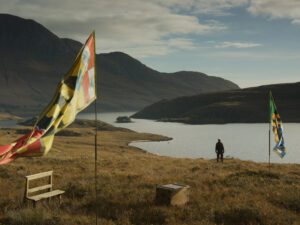The 60th Venice Biennale is titled Stranieri Ovunque – Foreigners Everywhere. It takes its name from Claire Fontaine’s neon sign sculptures that used the phrase. Furin drew inspiration from the name of an anarchist collective that fought against xenophobia in Turin in the early 2000s. Artistic Director of the Biennale, Adriano Pedrosa, explains, “One could say that wherever you are, wherever you go, there are always foreigners around you, but also on the other hand that wherever you go, you are always, deep down, a foreigner yourself in a more subjective manner—in a psychological, psychoanalytic way of thinking of ‘the foreign’.” In light of this, this year’s selection spotlights Indigenous and LGBTQ+ and artists, including the Brazilian collective MAHKU, and the Māori Mataaho Collective, and contemporary artists Isaac Chong Wai and Erica Rutherford. Within a line up of 87 national pavilions, the work of 331 artists are on display at the Giardini and the Arsenale. Here, we select 10 must-see pavilions from the 2024 edition, spanning large-scale video installation, to sculpture and immersive performance art.

Malta Pavilion | I Will Follow the Ship
Maltese artist Matthew Attard represents Malta this year with a solo exhibition that weaves together cultural heritage and cutting-edge digital technology. Co-curated by Elyse Tonna and Sara Dolfi Agostini, it marks the youngest ever team to represent the country at the bi-annual fair. The project takes inspiration from Attard’s interest in historical images of “ex-voto” (a votive offering of gratitude or devotion) and ship graffiti. These carvings can be found on the wayside chapels throughout Malta, and were crafted by seafarers due to the religious significance and political immunity these buildings offered. These maritime markings resonate with many cultures whose relationship with the sea has been, and still is, crucial.

British Pavilion | Listening All Night to the Rain
Artist and filmmaker John Akomfrah represents Britain this year with his boldest and most ambitious commission to date, drawing its title from 11th century Chinese writer Su Dongpo’s poetry, which explores the transitory nature of life during a period of political exile. Organised into a series of song-like movements or “cantos,” the exhibition, curated by Tarini Malik, brings together eight interlocking and overlapping multimedia installations into an immersive environment that tell stories of migrant diasporas in Britain. Commissioned by The British Council, the show is the result of decades of extensive research by the artist and his team, using historical records to contextualise our experience of the present day.

Portugal Pavilion | Greenhouse
Greenhouse the collective project by artist-curators Mónica de Miranda, Sónia Vaz Borges and Vânia Gala, creates a “Creole garden” in Venice’s Palazzo Franchetti. The immersive work references private plots tended by enslaved people as acts of resistance and survival – an antithesis of the monocultural plantation. The garden fosters a discursive space of liberation, possibility and multiplicity through a dense, and rich biodiverse landscape, unfixing hierarchical conventions. It stages a sound installation, sculptures, dance / performance, workshops and participatory events, staging a multidisciplinary space of collective possibility, experimentation and pedagogy. Rather than a static experience, it proposes a “living archive.”

Saudi Arabia | Shifting Sands: A Battle Song
In Shifting Sands: A Battle Song, installation artist Manal AlDowayan brings together the sonic and geological features of the desert, combining them with the voices and energy of Saudi women. Visitors are invited to wind their way through a maze of large-scale, printed silk, petal-like sculptures that take their forms from the desert rose, a crystal commonly found in the sands near the artist’s hometown of Dhahran. The symbol layers multiple dimensions: epehemerality, feminity, fragility and resilience. As with her earlier sculptures, the artist marks the surface of these outsized blooms with silkscreen drawings and text taken from workshops with Suadi women, or sourced from local and international news media.

Artist collaborative MADEYOULOOK, made up of Molemo Moiloa and Nare Mokgotho, presents multidisciplinary sound installation Quiet Ground at the South African Pavilion. The exhibition, curated by Portia Malatjie, is the result of seven years of research in the northern part of South Africa, on histories of land work, land repair and their connections to the country more broadly. The central piece of the show is an 8-channel composition that shows the power and place of rain and water in traditional South African society. The sound piece brings together field recordings from the natural landscape and interviews with land workers, healers and family memory — framed within the structure of a Johannesburg thunderstorm.

Kapwani Kiwanga is a multi-disciplinary, Aesthetica-featured artist who considers how diverse forms of power are manifested, how the histories they suppress are overlooked, and their impact on everyday life. Viewed from its facade, Trinket is a site-specific installation or a large-scale tableau. Here, the three-dimensional space collapses into a two-dimensional plane where distinctions between inside and outside dissolve. As a primary material, the artist uses conterie, or seed beads, a currency of tiny glass units that serve as an archive or witness to past transactions of the Venetian archipelago.

Singapore Pavilion | Seeing Forest
“Every forest is liminal, even one that grows in the centre of the city. Disregarded and disposable in urban planning, it remains a universe unto itself.” In Seeing Forest, Robert Zhao Renhui collaborates with curator Haeju Kim to explore the phenomena of “secondary forests.” The term refers to a woodland area which has regenerated through natural processes after human-caused disturbances, such as agriculture clearing. Renhui focuses on secondary forests in Singapore, unearthing the process of how the island has evolved, encapsulating the landscape’s histories of settlement, colonisation, migration and co-existence amongst species. Visitors are invited to examine the ways in which human urban design can shape the natural world.

Hong Kong Pavilion | Courtyard of Attachments
In Courtyard of Attachments, a collaboration between M+ and the Hong Kong Arts Development Council, Trevor Yeung explores personal experiences and observations of the relationships between humans and aquatic ecosystems. He draws from references that include his father’s seafood restaurant, pet shops, feng shui arrangements, and his childhood pet fish companions.In landscapes of fishless aquariums, Yeung places longing, desire, and power on display. His works contemplate absence and attachment as a way to comment on the systems that structure our lives while alluding to the current climate crisis. The exhibition invites us to consider the emotional disconnect and power dynamics that characterise society today.

Australia Pavilion | Kith and Kin
In kith and kin, Archie Moore draws on his Kamilaroi, Bigambul, British and Scottish heritage. His work brings international awareness to the vitality of First Nations kinship, in spite of facing systemic injustices since British invasion in 1770. Hand-drawn in white chalk, the genealogical chart unfolds across the Australian Pavilion’s five-metre-high black walls, illustrating Moore’s lineage stretching back more than 2,400 generations. Derived from the artist’s research with family, community and archivists, this intricate map of relations reflects the unique familial structures of First Nations Australians that includes all living things and affirms their status as some of the longest-continuous living cultures in the world.

Philippines Pavilion | Waiting just behind the curtain of this age
For its exhibit this year, the Philippines will be presenting Sa Kabila ng Tabing Lamang ng Panahong Ito (Waiting Just Behind the Curtain of this Age), featuring the work of Mark Salvatus curated by Carlos Quijon Jr. This multidisciplinary exhibition explores the ethno-ecologies of Mt. Banahaw and Lucban, the hometown of Salvatus. The centrepiece is a newly commissioned single-channel video delving into the mountain’s profound influence on Lucban’s musical traditions since the 1950s. This is complemented by a series of captivating fiberglass rock sculptures. Salvatus explains his vision, “The Pavilion aims to be a place for an imaginary journey, an invitation to glide within the space and redistribute energies.”
Biennale Arte 2024: Foreigners Everywhere | 20 April – 24 November
Image Credits:
Mónica de Miranda, Creole Garden, 2024, inkjet printon cotton paper, 120×80 cm© Mónica de Miranda, Courtesy of the artist.
Malta Matthew Attard, Eye-tracking concept sketch (I WILL FOLLOW THE SHIP), 2023. Eye-tracking drawing, Photo, Generative Algorithm. Digital image – Variable dimensions. © Matthew Attard and Galleria Michela Rizzo
John Akomfrah, Listening All Night To The Rain, British Pavilion, 60th International Art Exhibition of La Biennale di Venezia, 2024. Photo: Jack Hems
Mónica de Miranda, Crossing, 2024, inkjet print oncotton paper, 60×40 cm© Mónica de Miranda, Courtesy of the artist
Manal AlDowayan, Shifting Sands: A Battle Song, 2024. Photography by venicedocumentationproject. Courtesy of the Visual Arts Commission, the Commissioner for the National Pavilion of Saudi Arabia
MADEYOULOOK, Dinokana, 2024. Multimedia sound installation, dimensions variable. Photo: 3D rendering of Dinokana by 24/7 Architects. Courtesy of MADEYOULOOK and 24/7 Architects. Copyright MADEYOULOOK
Kapwani Kiwanga, installation view of the exhibition Kapwani Kiwanga: Trinket, 2024, Canada Pavilion, 60th International Art Exhibition – La Biennale di Venezia. Commissioned by the National Gallery of Canada and supported by the Canada Council for the Arts. © Kapwani Kiwanga / Adagp Paris / CARCC Ottawa 2024. Photo: Valentina Mori
Robert Zhao Renhui: Thermal image of a walker in the forest, still from The Owl, The Travellers and The Cement Drain, 2024. COURTESY ROBERT ZHAO RENHUI
Trevor Yeung: Courtyard of Attachments, Hong Kong in Venice, Collateral Event at the 60th International Art Exhibition – La Biennale di Venezia. (Ela Bialkowska)
Mark Salvatus, Kung ang Makagiginhawa ay Matingnan ng Ating mga Mata (Should the Source of Fulfillment Be Seen with Our Eyes), 2024, still, 4K video, colour, sound. Courtesy NCCA – PAVB
View of Archie Moore: kith and kin, Australia Pavilion at the Venice Biennale, 2024. Photo: Andrea Rossetti. © the artist. Image courtesy of the artist and The Commercial.





